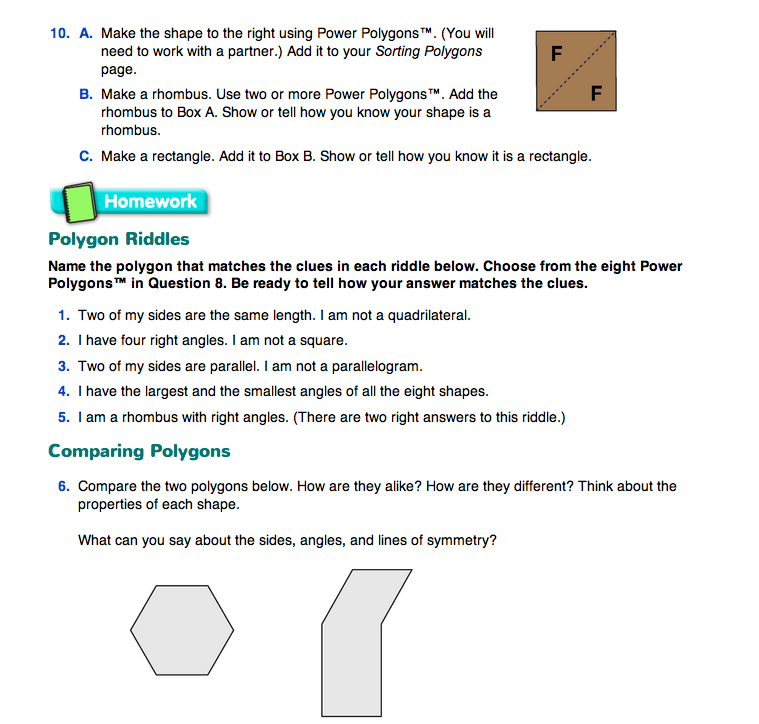Have students use Questions 8–10 in the Student Guide to bring together the big ideas of the lesson. Use Math Practices Expectation 5, on the Math Practices page in the Reference section to discuss how to use properties to explain their answers. A completed Show My Work page for Question 8 is shown in Figure 10.
Have students discuss Questions 9–10 with their partners. As students work, explore their thinking. Remind them to use the examples and properties on the wall charts for rhombuses and rectangles. Possible student language for answering Question 9 follows:
- Is a square also a rhombus (Question 9A)? (Yes. I looked at the wall charts for rhombuses and there was a picture of a square. The properties said that a rhombus has to have all four sides equal and opposite sides parallel. Squares have that, so you can call a square a rhombus, too.)
- Is a square also a rectangle (Question 9B)? (At first I thought, “No, a rectangle is long and a square is not, but then I looked at the properties on the rectangle chart. There was a square on the chart and the properties said, “Four sides, four right angles, two pairs of parallel sides.” So a square is a rectangle, too. A square has four equal sides, too, but that's extra.”)
- Are all rectangles squares (Question 9C)? (No, squares have all sides equal like on the rhombus chart. Not all rectangles have that, so all rectangles are not squares.)
Adding Squares to the Word Charts. Use students' responses to Questions 8–10 to add squares to the Geometry Word Chart.
- What shapes are both rhombuses and rectangles? (squares)
- Look carefully at the squares. Look carefully at the charts for rhombuses and rectangles. Work with your group to list properties of squares. Have each member of your group list at least one property.
Ask groups to list properties of squares for the chart. Have a volunteer draw a square as an example. Properties of squares include:
- Squares have four sides.
- All sides are equal length.
- All angles are equal. They are all right angles.
- Opposite sides are parallel.
- Squares have four lines of symmetry.
Assign the Shapes Quiz Assessment Masters. Students should work independently to complete this quiz. Students will need to use the Polygon Names pages in the Reference section of the Student Guide.
Have students cut out the shapes from the Shapes Quiz: Cut Outs Assessment Master before taking the quiz.
Use the Shapes Quiz Assessment Masters with Feedback Box to assess students' progress toward the Expectations below:
- E4.
- Draw and identify intersecting, perpendicular, and parallel lines.
- E5.
- Describe and analyze 2-dimensional shapes based on their properties (e.g., number and length of sides, number and size of angles, relationships between sides).
- E6.
- Classify 2-dimensional shapes using their properties.
- E7.
- Identify line (reflective) symmetry.
- E8.
- Identify congruent shapes.
- E9.
- Identify slides, flips, and turns of shapes.
- E10.
- Justify conclusions using geometric properties.
Use the feedback to guide students' choices for targeted practice on these Expectations in the Workshop in Lesson 11. The Mystery Properties game and the Mystery Shapes game provide targeted practice.
















